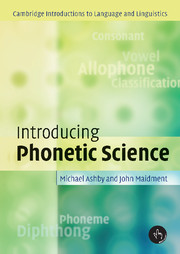8 - Speech sounds and speech movements
Published online by Cambridge University Press: 05 June 2012
Summary
CHAPTER OUTLINE
In this chapter you will learn about: sounds involving more than one articulation; how sounds are influenced by neighbouring sounds; overlapping articulations; variation in segment duration; how to draw diagrams of estimated articulator movements.
KEY TERMS
Advanced
Coarticulation
Labialisation
Palatalisation
Palatography
Parametric diagrams
Pharyngealisation
Pre-fortis clipping
Pre-pausal lengthening
Primary and secondary articulation
Retracted velarisation
Introduction
In previous chapters we have gradually built up the descriptive framework that enables us to understand most of the ways in which speech sounds can differ from each other. For example, in the case of consonant sounds, we have looked at the airstream mechanism, at the various functions of the larynx, and at places and manners of articulation. There is still more to be done, though, because so far we have been assuming for the sake of simplicity that segments occur one-at-a-time in a sequence, and that within each segment there is one articulation at a time. Both of these assumptions need to be modified, because by themselves they lead to a very static view of what speech is like. The articulators and the places of articulation we have identified, for example, are nothing like as tidy and distinct in reality as our labels suggest. We have only to look inside our own mouths with a mirror, or at an X-ray picture of the vocal tract, to be reminded that the tongue is not divided neatly into the sections we have labelled blade, front and back, or that it is very hard to say where the alveolar ridge ends and the hard palate begins.
- Type
- Chapter
- Information
- Introducing Phonetic Science , pp. 117 - 134Publisher: Cambridge University PressPrint publication year: 2005



